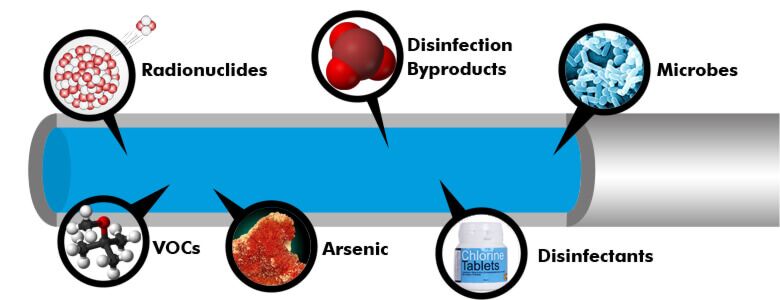
Most Common Water Contaminants Index Page
Drinking water, including bottled and tap water, may reasonably be expected to contain at least small amounts of some contaminants. In the United States, the EPA (Environmental Protection Agency) sets strict standards for approximately 90 different types of contaminants that can be found in drinking water. On this page, we have compiled a list of the most common water pollutants and categorized them below to provide you with detailed information on specific contaminants and their effects on your health.
Microbes ~ Radionuclides ~ Inorganics ~ Volatile Organics ~ Disinfectants ~ Disinfection Byproducts ~ MTBE
Inorganic Contaminants
|
Antimony Asbestos Barium Beryllium |
Cadmium Chromium Copper |
Cyanide Lead Mercury |
Nitrate/Nitrite Selenium Thallium |
Arsenic is a highly toxic heavy metal. Some people who drink water containing arsenic in excess of EPA's standard over many years could experience a wide range of serious problems. Health concerns include damage to the bladder, lungs, heart, kidney and liver. Arsenic can also harm the central & peripheral nervous system and circulatory system. Arsenic exposure has been linked to several types of cancers.
Fluoride. Many communities add fluoride to their drinking water to promote dental health. Each community makes its own decision about whether or not to add fluoride. EPA has set an enforceable drinking water standard for fluoride of 4 mg/L (some people who drink water containing fluoride in excess of this level over many years could get bone disease, including pain and tenderness of the bones). EPA has also set a secondary fluoride standard of 2 mg/L to protect against dental fluorosis. Dental fluorosis, in its moderate or severe forms, may result in a brown staining and/or pitting of the permanent teeth. This problem occurs only in developing teeth, before they erupt from the gums. Children under nine should not drink water that has more than 2 mg/L of fluoride.
Lead typically leaches into water from plumbing in older buildings. Lead pipes and plumbing fittings have been banned since August 1998. Children and pregnant women are most susceptible to lead health risks. For advice on avoiding lead, see the how to remove lead in your drinking water fact sheet prepared by EPA.
Volatile Organic Contaminants (VOCs)
Read Next: Health Risks of Heavy Metals


